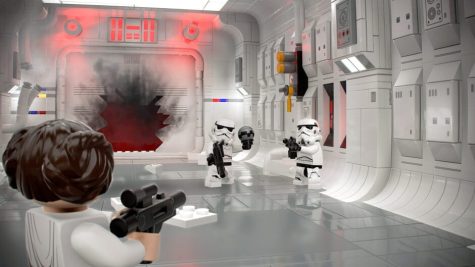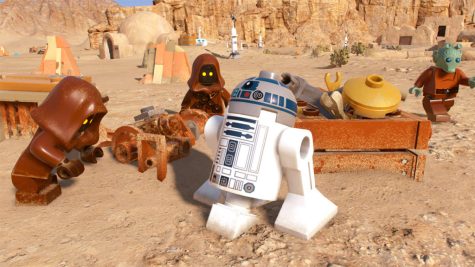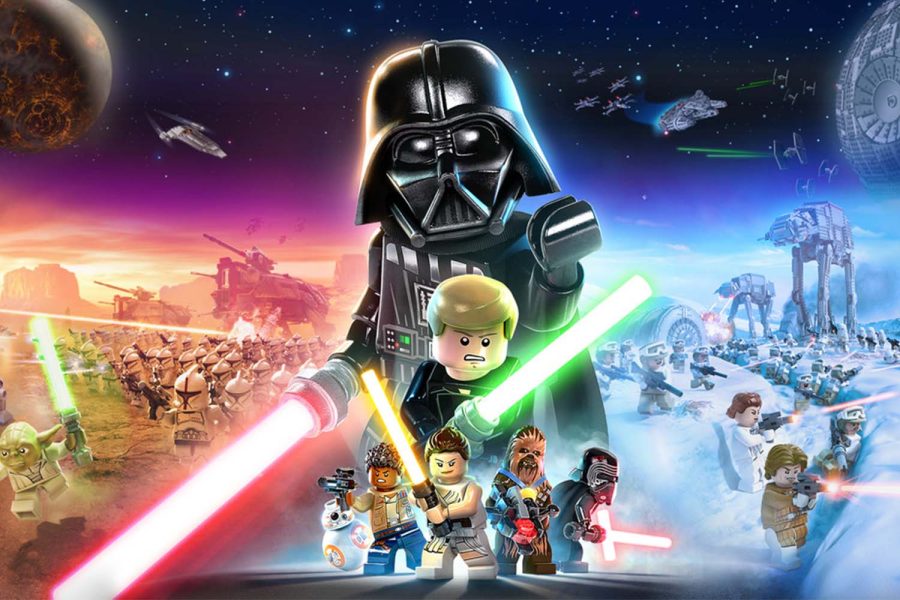“Lego Star Wars: The Skywalker Saga,” shows the light and dark side of a game 15 years in the making
April 21, 2022
If you are anything like me, then Star Wars is a fundamental aspect in the way you live.
I know that might sound silly to say, but when you can’t remember the first time you did something, in my case the first time I watched Star Wars, then you are inclined to defend such a serious stance as Star Wars being a necessity in one’s life.
Star Wars is so important to me that when I applied to colleges as a filmmaking major, I wrote about my undying interest in the science fiction universe that is Star Wars and how it has fostered my own interest in being a storyteller.
In my college application I wrote that in my adolescence, I used Lego mini-figures as my own actors in stop motion animations in the pursuit of being a storyteller.
However, the use of the Lego mini-figures was not only bound to the reality of my stories and their set-pieces, they were also manipulated by the controller of my Nintendo DS, a handheld gaming system.
“Lego Star Wars: The Complete Saga,” which released November 6, 2007, was an undeniable masterpiece of a videogame, combining the stories of the Star Wars universe and the creative aspects of Lego pieces into a beautiful blend of entertainment – one that indulged the mind of young elementary students such as myself.
As a kid, being able to play with Legos in both videogames and as a tangible toy was vital in fostering my creativity not only as a child but as a senior in high school today.
Fifteen years after the release of “Lego Star Wars: The Complete Saga”, Lego Star Wars has returned to its long-lasting legacy with the release of “Lego Star Wars: The Skywalker Saga.”
Developed by Traveller’s Tales and published by Warner Bros. Interactive Entertainment, “Lego Star Wars: The Skywalker Saga” was released on April 5, 2022 for Xbox One, Playstation 4, PlayStation 5, and Nintendo Switch consoles, and a Microsoft Windows release for PC users.
Players can pick up the Nintendo Switch edition for $70, which is reasonably justifiable because the bonuses for the deluxe edition included a Lego mini-figure and Steelbook case that together can reach $200 dollars in resale value, independent of the actual game.
Story – “You must unlearn what you have learned.”

Upon starting up the game the player is greeted with a montage of some of the greatest moments in Star Wars history recreated with Lego mini-figures, with lightsabers clashing and Lego bricks flying into the air.
This brilliantly establishes the purpose of this game: this is not a retelling of the Star Wars stories in the format of a video game, it is rather a chance for gamers to live through the plastic eyes of Lego Star Wars character and relive the fun of watching good and evil battle over the silver screen.
Since the story is being told through the lens of an established “kid’s” toy, there are a plethora of jokes to be told that not only appeal to the the target audience of giggling kids, but also to an older audience, with a “yo mama” joke in Episode IX making me laugh out loud.
Besides the jokes, there are parts of the game that either feel too rushed or lasted longer than they needed to.
For example, in a playthrough of “Star Wars Episode IV: A New Hope,” the player starts off in the corridors of the Tantive IV as Princess Leia solves puzzles to escape off of the spaceship being attacked by the forces of the empire, led by Darth Vader. This process takes place over a few minutes in the theatrical release, while in the Lego rendition, it takes nearly 20 minutes to pass the level.

Juxtaposing the first level of Leia’s unsuccessful escape is the final level of the episode in which Luke Skywalker initiates his final assault on the Death Star., which only took a few minutes to complete, after being stunned by the plastic detail of the trench walls of the Death Star.
Players want to experience the climax of each of the Star Wars movies, reliving the exact moment of victory in each film, rather than an establishing scene such as Leia on the Tantive IV.
However, it should be recognized that these levels were based on two different mechanics of gameplay and could be blamed for the difference in run time and story stagnation.
Gameplay – “The Force is strong with this one.”
The two types of gameplay mentioned above can be classified as either mini-figure gameplay or spaceship gameplay.
The mini-figure gameplay is relatively self-explanatory: the player is thrown into various situations, with the player being able to solve puzzles, blast their way through enemy entrenchments and perform button combos to take down powerful bosses in a third-person action/adventure framework.

This new aspect of button combos made the gameplay much more enjoyable than the combat system in “Lego Star Wars: The Complete Saga,” in which mashing one button for attack is the norm, rather than the dynamic system of carefully pressing buttons in a specific order to make Luke Skywalker slam into the ground with his lightsaber.
It should be noted that the game doesn’t quite teach you how to perform these combos, and thus the instincts of the player must kick in to find what combo might work for a particular situation, but all of them help accomplish the same goal: destroy the brick-built enemy.
After playing through all of the game, if you’re a new player and you desire a challenge, then you should turn off the aim assist and health recovery in the settings so that playing the game won’t feel like a total breeze.
The other category, spaceship gameplay, is one of the real triumphs of the game.
To understand the enjoyment of these types of levels, you can take a look at Luke’s Death Star trench run in “Episode IV.” Being able to dodge the attacks of following TIE Fighters and shoot down attacking turrets reminded me of the combat found in the “Star Wars: Battlefront” series, which poses a much grittier rendition of Star Wars video games combat. “Star Wars: Battlefront” mastered the concept of science fiction space combat, and it is beautifully translated into “Lego Star Wars,” thanks to brick built models of every space ship you find yourself in the cockpit of.

Each time I started up a level in which I needed to drive some sort of Star Wars machinery, like Anakin, I got giddy and felt the urge to exclaim, “now this is podracing!”
Performance – “I have a bad feeling about this.”
Another triumph of this era of Lego Star Wars is the graphics. Thanks to proper shading, the game feels wonderful and is reminiscent of the cinematography of the films.
While playing the Nintendo Switch version of the game, I encountered some pretty strange bugs. Some of the cutscenes have delayed starts, and in some instances, while locked in combat, enemies would strangely lift up into the sky.
Although the convenience of the game on Switch is great, the performance still leaves some to be desired. Even on high-end PCs, there have been reports of slight performance issues.
Despite these performance issues, this video game covers so much of not only the Star Wars universe, but also the universe of gaming.
Outside of the story levels, which there are five of for each of the nine main series films, there is a whole galaxy of 24 open-world planets to explore, an achievement in modern gaming.
Open worlds are the best way to feed an exploratory spirit through video games, something that some of my favorite video games such as “The Legend of Zelda: Breath of the Wild,” “No Man’s Sky” and now Lego Star Wars: The Skywalker Saga do extremely well as an aspiring explorer myself.
Even though I have mainly been occupied with the story levels since the time of release, there are still thousands of collectibles left to find in the open world and plenty of characters to interact with, and those tiny quips from characters are adorable.

Controversy – “If only you knew the power of the dark side.”
Star Wars is most known for its proper use of world building, and “Lego Star Wars: The Skywalker Saga” lives up to that reputation.
“Lego Star Wars: The Skywalker Saga” was announced first in May of 2020, and after three delays over the past two years, it has lived up to its hype. The game overall builds off of the concepts we all loved in The Complete Saga and introduces a new era of Lego video games.
Many video game developers have fallen into the trap of “crunch culture,” the process in which programmers are forced to work on the game on over time to finish it by a certain release window.
Back in January, many video game journalists sites such as Polygon accused Traveller’s Tales, the game’s developer, of forcing their employees to crunch during the game’s development.
I think that the game is wonderful and is a great addition to the Lego Star Wars universe. However, I also find myself feeling that I could’ve waited until later this year to play a game which the employees of Traveller’s Tales felt proud to make, rather than one they were forced to.
Crunch culture is a plague that has infected the gaming industry, and though Traveller’s Tales has not been the sole proprietor of its growth, they should still be held accountable.
Conclusion – “I’m one with the Force. The Force is with me.”
Lego Star Wars: The Skywalker Saga is an epic video game, one that rivals its predecessor and ushers in a new era of Lego video games.
However, the AAA price tag of $60 can be quite hefty for someone who wants to play the game for its mechanics rather than a die-hard Star Wars fan who pre-ordered the game before they even knew how much it would cost.
Paying the price now feels like a way to respect everyone at Traveller’s Tales that seemed to put their all into the game, but in a systemic cycle of video game capitalism that has proven to be relentless to both consumers and developers, waiting for a sale would be a better choice for some.
I recommend picking up the game at some point, and when you do, take some of the training wheels off in the game’s settings, find a Star Wars fanatic to play with, and from there, “may the force be with you.”
[sno-poll id=”26869″ result_color=”#000E3E” tile_color=”#ffffff” align=”center” background=”on” background_color=”#ffffff” border=”all” border_color=”#888888″ border_size=”5px” shadow=”on”]












